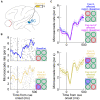Dissociable Cortical and Subcortical Mechanisms for Mediating the Influences of Visual Cues on Microsaccadic Eye Movements
- PMID: 33776656
- PMCID: PMC7991613
- DOI: 10.3389/fncir.2021.638429
Dissociable Cortical and Subcortical Mechanisms for Mediating the Influences of Visual Cues on Microsaccadic Eye Movements
Abstract
Visual selection in primates is intricately linked to eye movements, which are generated by a network of cortical and subcortical neural circuits. When visual selection is performed covertly, without foveating eye movements toward the selected targets, a class of fixational eye movements, called microsaccades, is still involved. Microsaccades are small saccades that occur when maintaining precise gaze fixation on a stationary point, and they exhibit robust modulations in peripheral cueing paradigms used to investigate covert visual selection mechanisms. These modulations consist of changes in both microsaccade directions and frequencies after cue onsets. Over the past two decades, the properties and functional implications of these modulations have been heavily studied, revealing a potentially important role for microsaccades in mediating covert visual selection effects. However, the neural mechanisms underlying cueing effects on microsaccades are only beginning to be investigated. Here we review the available causal manipulation evidence for these effects' cortical and subcortical substrates. In the superior colliculus (SC), activity representing peripheral visual cues strongly influences microsaccade direction, but not frequency, modulations. In the cortical frontal eye fields (FEF), activity only compensates for early reflexive effects of cues on microsaccades. Using evidence from behavior, theoretical modeling, and preliminary lesion data from the primary visual cortex and microstimulation data from the lower brainstem, we argue that the early reflexive microsaccade effects arise subcortically, downstream of the SC. Overall, studying cueing effects on microsaccades in primates represents an important opportunity to link perception, cognition, and action through unaddressed cortical-subcortical neural interactions. These interactions are also likely relevant in other sensory and motor modalities during other active behaviors.
Keywords: brainstem omnipause neurons; fixational eye movements; frontal eye fields; microsaccades; primary visual cortex; superior colliculus; visual attention; visual selection.
Copyright © 2021 Hafed, Yoshida, Tian, Buonocore and Malevich.
Conflict of interest statement
The authors declare that the research was conducted in the absence of any commercial or financial relationships that could be construed as a potential conflict of interest.
Figures









Similar articles
-
Dynamics of fixational eye position and microsaccades during spatial cueing: the case of express microsaccades.J Neurophysiol. 2018 May 1;119(5):1962-1980. doi: 10.1152/jn.00752.2017. Epub 2018 Feb 21. J Neurophysiol. 2018. PMID: 29465321
-
Microsaccades: Empirical Research and Methodological Advances - Introduction to Part 1 of the Thematic Special Issue.J Eye Mov Res. 2020 Jun 19;12(6):10.16910/jemr.12.6.1. doi: 10.16910/jemr.12.6.1. J Eye Mov Res. 2020. PMID: 33828747 Free PMC article.
-
Visual feature tuning of superior colliculus neural reafferent responses after fixational microsaccades.J Neurophysiol. 2020 Jun 1;123(6):2136-2153. doi: 10.1152/jn.00077.2020. Epub 2020 Apr 29. J Neurophysiol. 2020. PMID: 32347160
-
Active vision at the foveal scale in the primate superior colliculus.J Neurophysiol. 2021 Apr 1;125(4):1121-1138. doi: 10.1152/jn.00724.2020. Epub 2021 Feb 3. J Neurophysiol. 2021. PMID: 33534661 Review.
-
Vision, Perception, and Attention through the Lens of Microsaccades: Mechanisms and Implications.Front Syst Neurosci. 2015 Dec 2;9:167. doi: 10.3389/fnsys.2015.00167. eCollection 2015. Front Syst Neurosci. 2015. PMID: 26696842 Free PMC article. Review.
Cited by
-
Faster Detection of "Darks" than "Brights" by Monkey Superior Colliculus Neurons.J Neurosci. 2022 Dec 14;42(50):9356-9371. doi: 10.1523/JNEUROSCI.1489-22.2022. Epub 2022 Nov 1. J Neurosci. 2022. PMID: 36319117 Free PMC article.
-
Distinctive pupil and microsaccade-rate signatures in self-recognition.J Vis. 2025 Apr 1;25(4):16. doi: 10.1167/jov.25.4.16. J Vis. 2025. PMID: 40298894 Free PMC article.
-
Brain-wide arousal signals are segregated from movement planning in the superior colliculus.bioRxiv [Preprint]. 2025 Jun 27:2024.04.26.591284. doi: 10.1101/2024.04.26.591284. bioRxiv. 2025. PMID: 38746466 Free PMC article. Preprint.
-
Express detection of visual objects by primate superior colliculus neurons.Sci Rep. 2023 Dec 8;13(1):21730. doi: 10.1038/s41598-023-48979-5. Sci Rep. 2023. PMID: 38066070 Free PMC article.
-
Severe distortion in the representation of foveal visual image locations in short-term memory.Proc Natl Acad Sci U S A. 2022 Jun 14;119(24):e2121860119. doi: 10.1073/pnas.2121860119. Epub 2022 Jun 8. Proc Natl Acad Sci U S A. 2022. PMID: 35675430 Free PMC article.
References
Publication types
MeSH terms
LinkOut - more resources
Full Text Sources
Other Literature Sources
Miscellaneous

